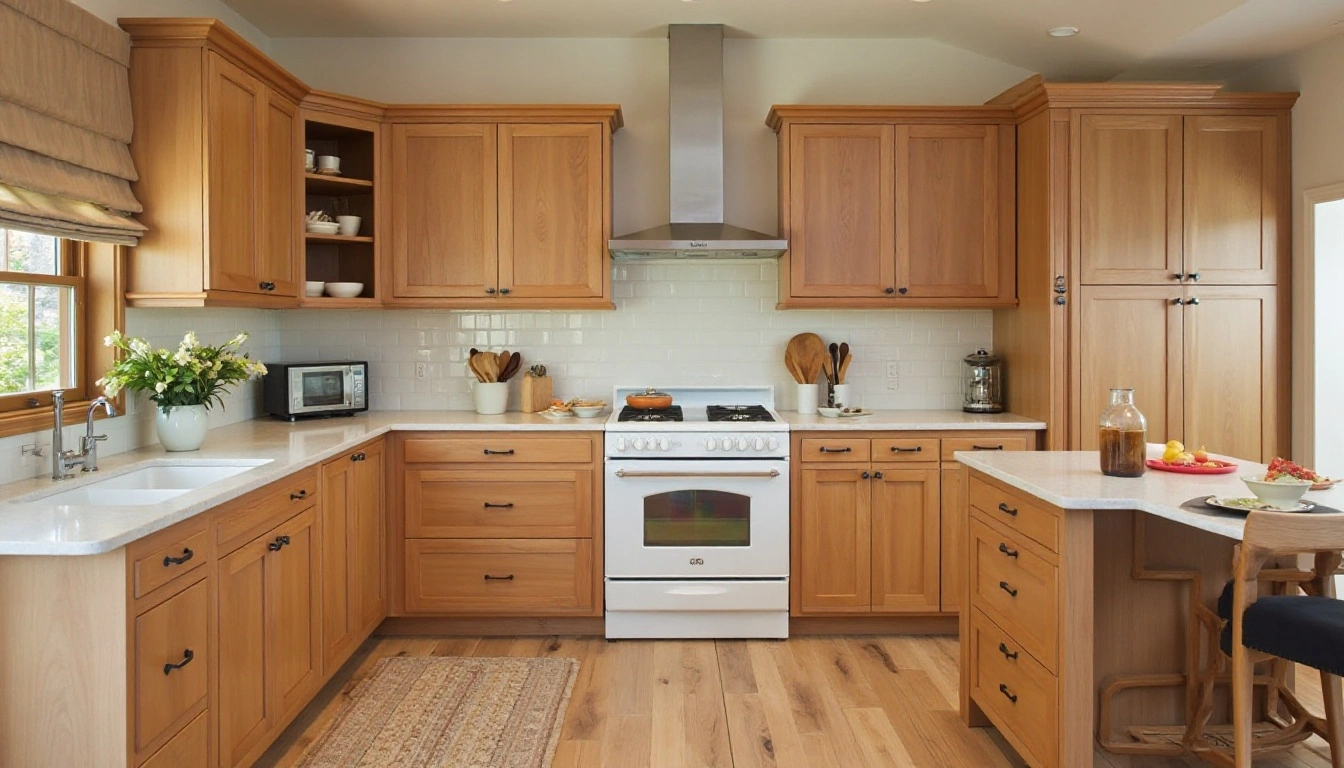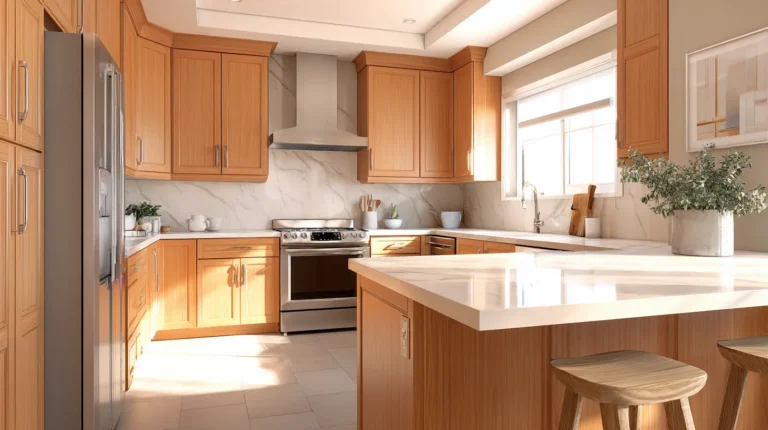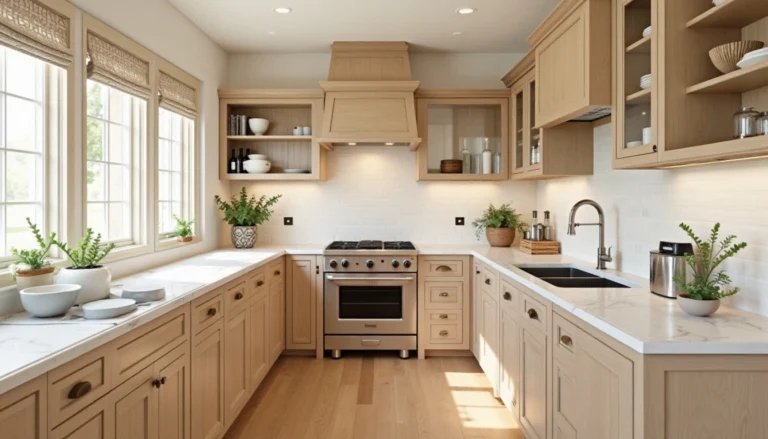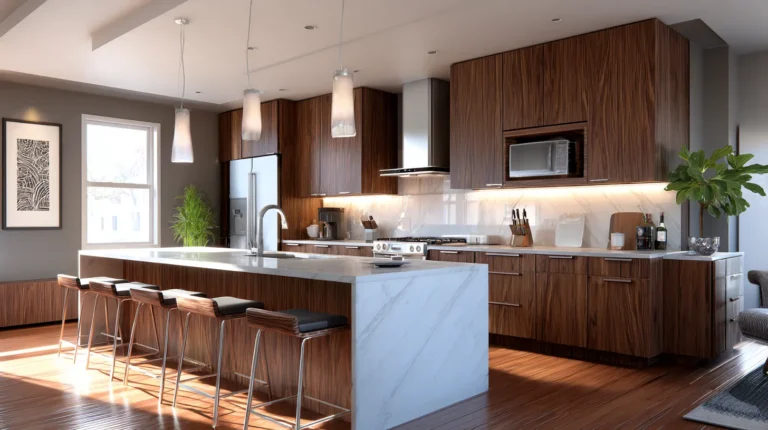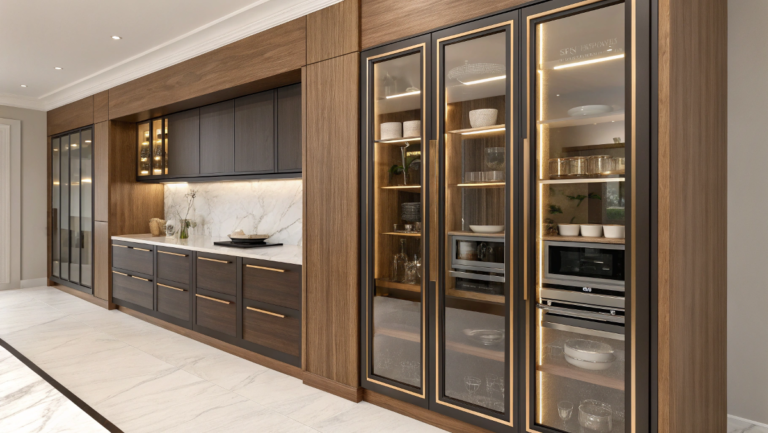Warm Wood Kitchen Cabinets Style Without the Dated Look
Warm wood kitchen cabinets aren’t just nostalgic — they’re quietly becoming the heart of modern kitchens. Somewhere between the sleek all-white trend and the moody dark tones, these honeyed, chestnut, and oak hues bring something deeper: soul.
I discovered this by accident while sanding down my grandma’s 1970s cabinets. The wood was scratched and sun-faded, but as I worked, a golden glow peeked through, and suddenly, the kitchen felt warm again. Not perfect. But perfectly lived-in.
This article is for anyone who’s looked at their old wood cabinets and wondered: can I work with what I’ve got? (Spoiler: yes.) We’ll explore what makes warm wood work, how to avoid the dreaded dated look, and the small design moves that make a big difference.
Understanding Warm Wood: It’s a Feeling, Not Just a Finish
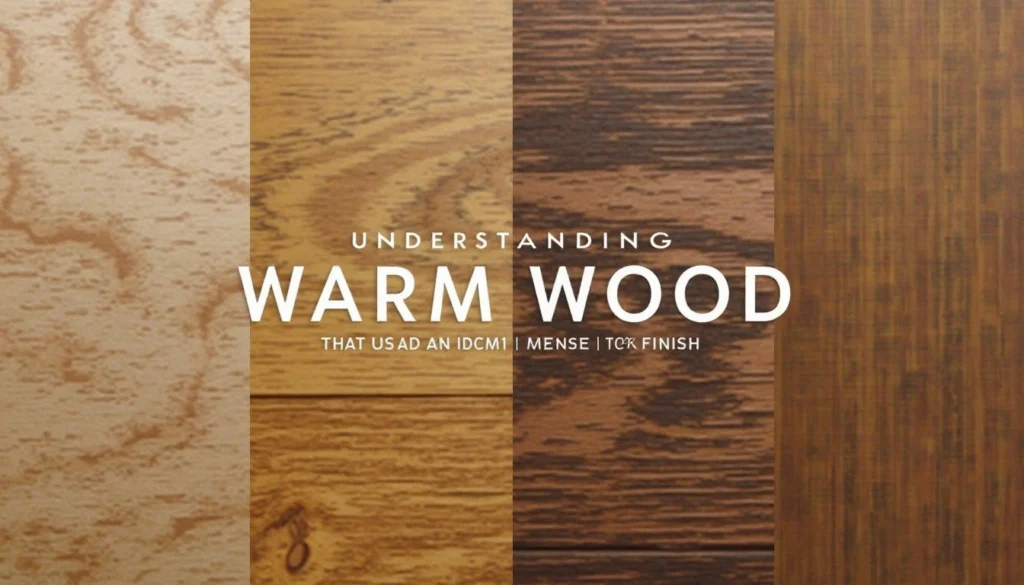
Let’s get one thing straight: warm wood isn’t just about color charts and product specs. It’s about how a kitchen makes you feel when the light hits just right and everything softens. It’s that rich, golden undertone that whispers, “stay a while.” And if you’ve ever run your hand along an old oak drawer that’s seen a hundred family meals, you already know the vibe.
Here’s the thing I didn’t expect when I first refinished my cabinets: the wood tone changed everything. Same layout, same counters, but once those warm tones came through? The kitchen felt grounded. Human. Like it had a memory.
Different woods give off different warmth. White oak leans golden and grainy, while cherry has that slow-burning red that deepens over time. Maple’s lighter but takes stain like a champ. And hickory—well, it’s got a personality. High contrast, wild grain, like it’s always telling a story.
What matters most isn’t just the wood, though. It’s the finish. A clear matte can feel airy and fresh, while a heavier stain brings out depth and age. I’ve seen folks ruin great wood with orange-gloss disasters, so yeah—choose carefully. Or better yet, test it under your kitchen lights first. (Trust me on that one.)
Wait, so what’s the “warmest” wood vibe?
-
White oak: soft golden, forgiving grain, works with most palettes
-
Cherry: reddish warmth, darkens over time like a good leather bag
-
Hickory: dramatic, a bit rustic, always feels alive
-
Maple: neutral by nature, but plays well with stains
-
Walnut (light-stained): cozy, grounded, richer than it looks at first glance
Can I turn my cool-toned cabinets warm?
Actually… yes. But it’s all in the stain. Even birch or ash can pull off a warm tone if you use something like golden oak or an amber poly. Just make sure you sample it first, and maybe ask yourself what kind of warmth you’re going for: subtle and calm, or bold and vintage?
Why Warm Wood Cabinets Are Back (And Cooler Than Ever)
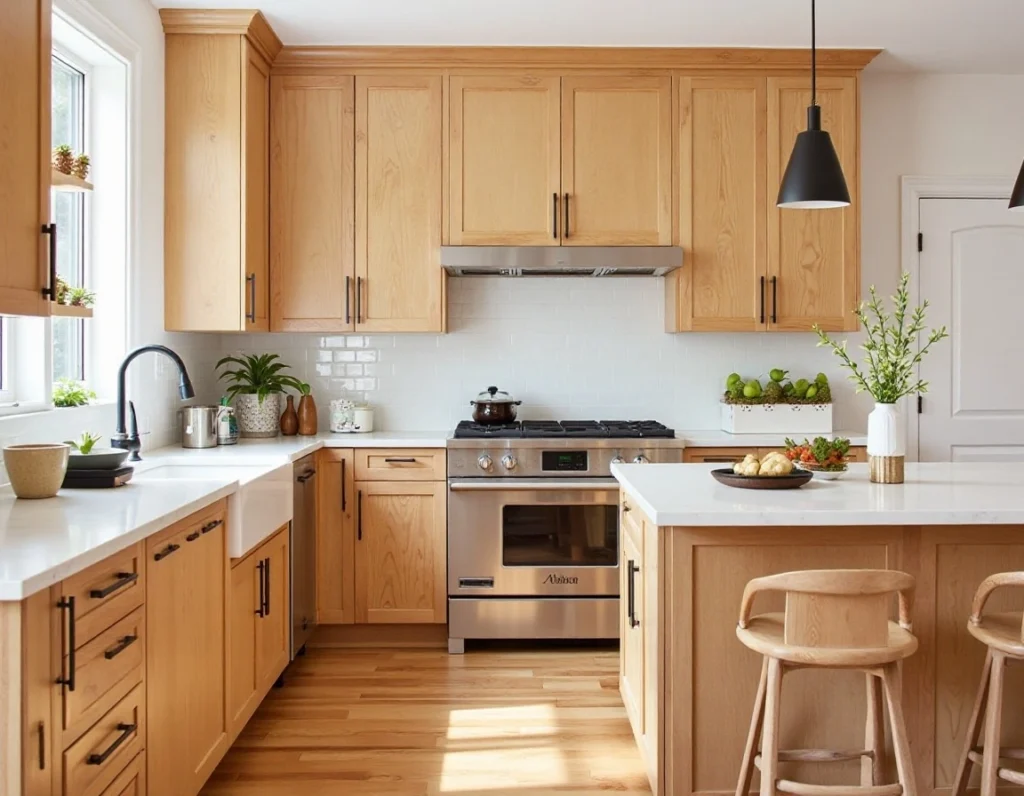
It’s funny how trends loop. Just a few years ago, everyone was painting over their oak cabinets, racing toward icy whites and steely grays. Now? Designers and homeowners alike are circling back to warm wood, not as a throwback, but as a statement.
The difference is in the intention. Today’s warm wood kitchens aren’t a copy of the ‘90s honey oak look. They’re richer, more balanced. Think natural white oak with soft-grain textures, or chestnut finishes paired with minimalist hardware. The goal isn’t to scream “rustic”—it’s to whisper comfort without compromising style.
Even the color trends are shifting. Brands like Sherwin-Williams and Benjamin Moore are pushing softer neutrals: beiges, putty tones, earthy taupes. These pair beautifully with warm wood, making the kitchen feel cohesive and intentional. We’re seeing a move away from the sterile-white aesthetic toward something that feels more grounded… more human.
Pinterest boards are filling up with two-tone combos—wood lowers, painted uppers, and natural finishes that let the grain do the talking. Warm wood is no longer a compromise; it’s a design choice with presence.
What’s driving the comeback?
-
Biophilic design: People crave connection to nature, and real wood delivers that tactile, visual warmth.
-
Design fatigue: After years of cold, gray, and glossy everything, warm textures feel refreshing.
-
Timelessness: Natural wood wears in, not out. It ages with grace.
Will warm wood cabinets go out of style again?
Eventually, everything cycles. But natural wood has a longer shelf life because it isn’t a fad, it’s a material. With thoughtful styling, warm cabinets can evolve with trends instead of fighting them.
Achieving the Right Tone: How to Make Warm Wood Work (Without Regrets)
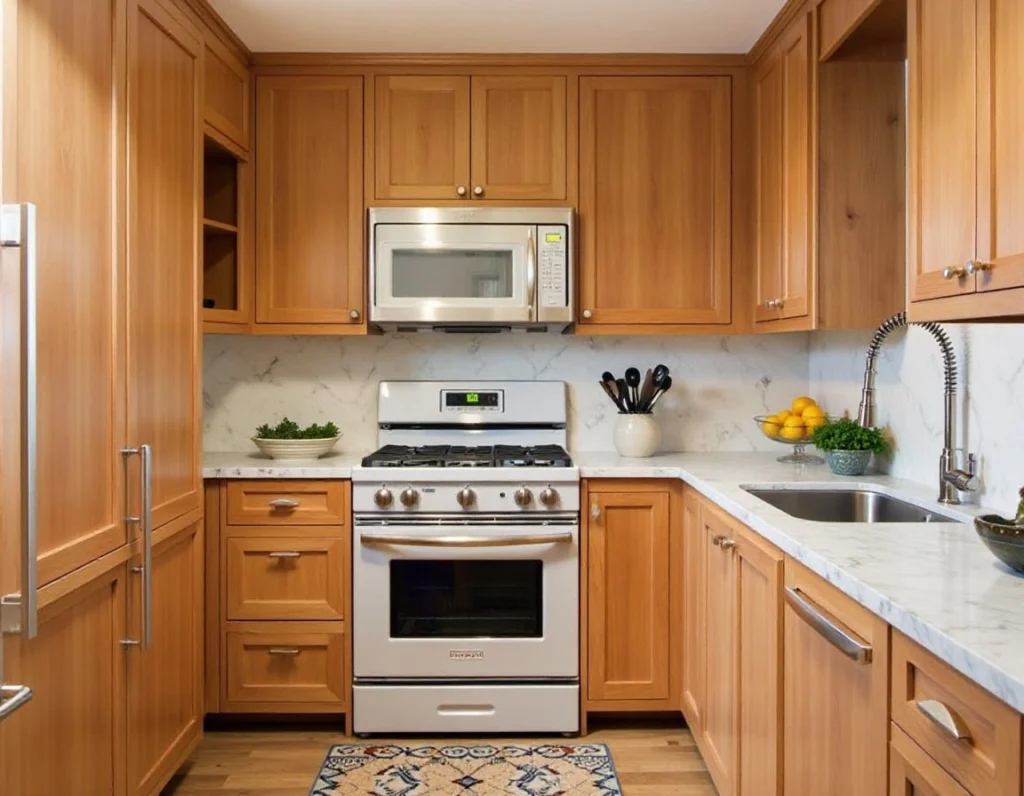
Warm wood is gorgeous—until it isn’t. You’ve probably seen kitchens where the cabinets lean too orange, or where the finish feels heavy and muddy. The difference between cozy and clunky? Tone.
Nailing the right tone starts with knowing your wood. White oak, for instance, naturally runs neutral to golden, while red oak or cherry can veer too warm if you’re not careful. But the real wildcard? The finish. A stain or sealant can completely shift a cabinet’s mood.
If you’re going DIY, water-based finishes tend to keep things light and clear, preserving the wood’s natural glow. Oil-based ones deepen the color, which can be beautiful… or a bit much, depending on your space and lighting. My advice? Always test on a scrap or hidden spot. What looks subtle in the can might turn nuclear under your kitchen lights.
Also, look at what’s around your cabinets. A warm wood finish might feel overpowering next to yellow-toned floors, but it is stunning against cool marble counters or matte black fixtures. Contrast matters.
Tips for getting the tone just right:
-
Use samples and test under your real lighting
-
Balance warm woods with cooler elements (walls, counters, hardware)
-
Avoid high-gloss unless you want serious reflection
-
Layer in texture (like matte tile or brushed metals) to soften the glow
My cabinets turned out too warm. Can I fix it?
Yes, but it depends. If you haven’t sealed them yet, try a cooler-toned stain overlay or glaze. If they’re already finished, you can tone it down with paint, new hardware, or contrasting design elements. Worst-case? Strip and start again—but only if you’re up for the mess.
Avoiding Outdated Vibes: Warm, Not Stuck in the Past
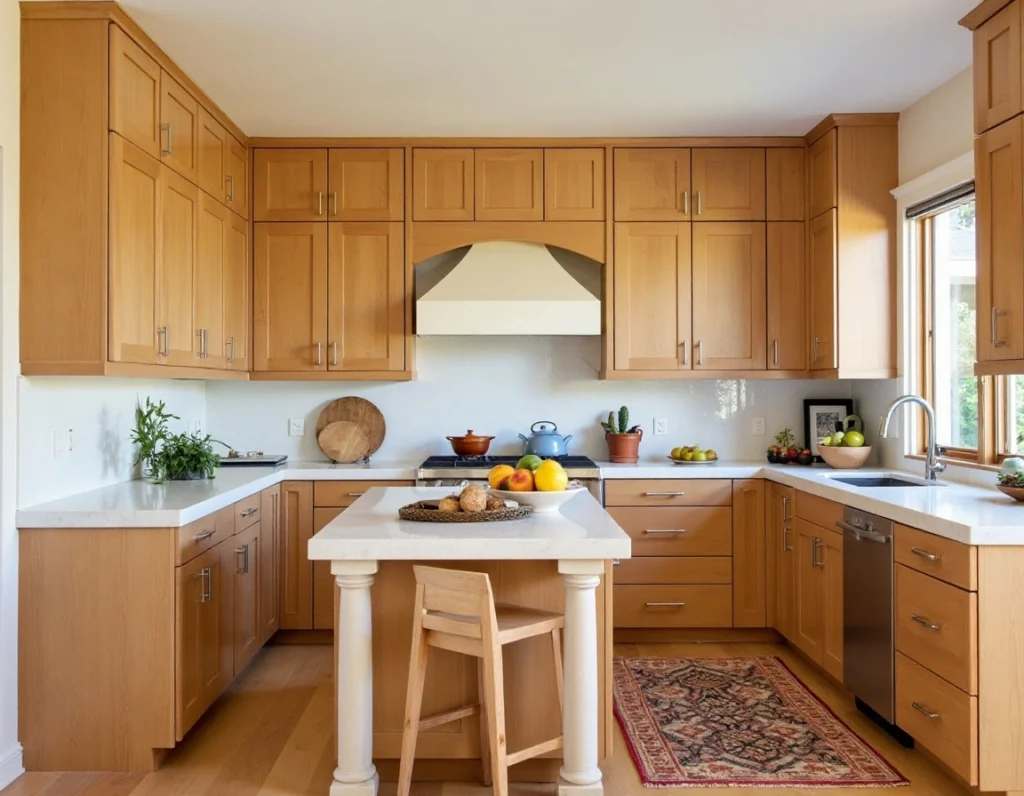
Here’s the part most people worry about: “Is this going to look like my aunt’s kitchen from 1992?” Fair question. Warm wood gets a bad rap not because of the material itself, but because of how it’s styled—or rather, how it was styled.
The difference between charming and dated often comes down to detail. Those cathedral-arched cabinet doors with the heavy hardware? Yep, that’s what triggers the flashbacks. But switch to flat-panel or clean shaker fronts, and suddenly your oak cabinets feel intentional, like they belong in a design magazine, not a time capsule.
Color mixing helps, too. Don’t feel boxed into all-wood everything. Some of the most eye-catching kitchens today combine wood lowers with painted uppers in soft white, sage, or even charcoal. It lightens the visual weight and gives the eye somewhere to rest.
And then there’s texture. Add woven bar stools, stoneware dishes, a linen runner, anything that breaks the “matchy-matchy” look. These details add freshness without you having to gut your kitchen.
Ways to modernize warm cabinets:
-
Replace ornate cabinet doors with shaker or slab fronts
-
Mix in painted elements (islands, uppers, walls)
-
Upgrade hardware: go brushed brass, matte black, or minimal chrome
-
Add modern lighting: think oversized pendants or globe sconces
-
Layer textures: ceramics, textiles, natural stone
Should I paint over my old wood cabinets?
Only if you truly hate the tone and can’t make it work. Sometimes, a change in lighting, wall color, or hardware can breathe new life into wood you thought was hopeless. Give it a chance to evolve before you commit to paint.
DIY & Budget Upgrades Small Moves, Big Payoff
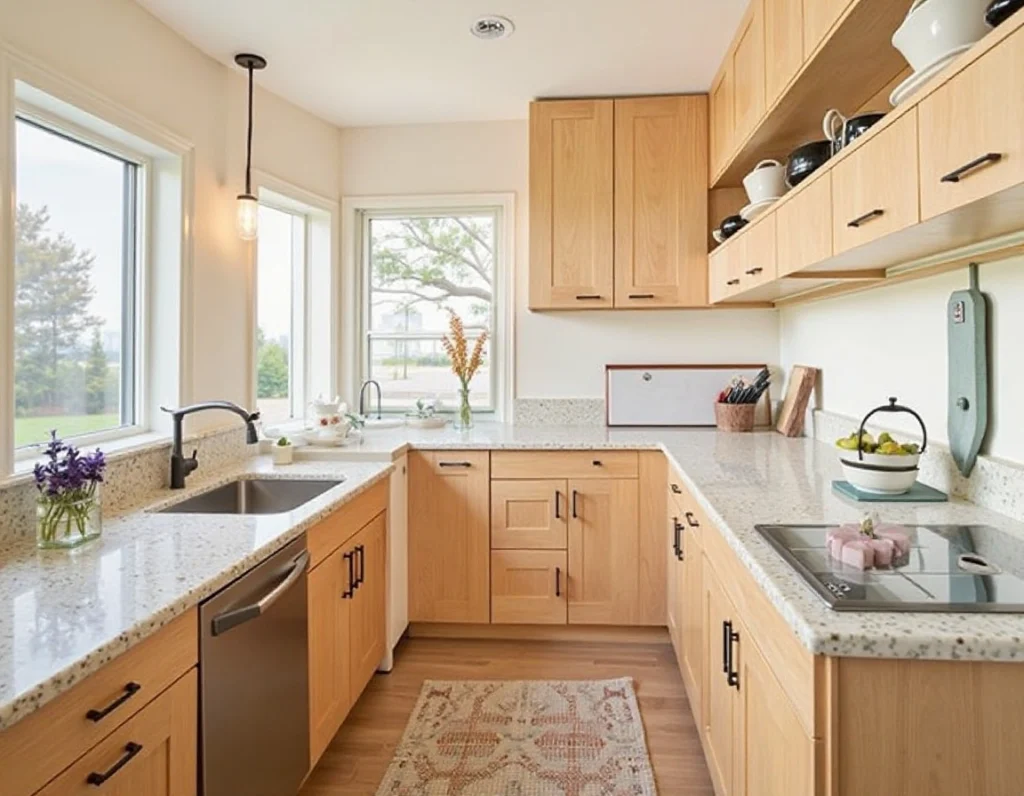
Not everyone’s got ten grand sitting around for a kitchen makeover—and honestly, you don’t need it. Warm wood cabinets can go from “ehh” to “oh wow” with just a few low-key tweaks, no sledgehammer required.
Start with hardware. It’s the easiest facelift you’ll ever give a kitchen. Those chunky, dated knobs? Gone. Swap in matte black pulls or brushed brass handles, nothing fussy, just clean and modern. Suddenly, your cabinets aren’t yelling 1997 anymore.
Next: lighting. I didn’t realize how much my old overhead fixture was messing with the wood tone until I changed the bulb. That amber cast was making everything feel more orange than it really was. Cooler LED strips under the cabinets? Game changer. They made my oak look intentional—like I planned it that way.
And honestly, don’t sleep on the soft stuff. A textured rug, some open shelving, maybe a set of linen curtains… it’s not just decor. It breaks up the wood, adds depth, and makes the room breathe. I’ve had people walk in and say, “Did you redo the kitchen?” Nope—just styled it better.
If you’re feeling brave, yes, you can refinish the cabinets yourself. Sanding is a dusty beast, but if you’ve got time and podcasts, it’s doable. I once spent a full Saturday bringing down the red tones on a cherry set—ended up with this beautiful toasted finish that looked completely custom.
Quick, wallet-friendly upgrades:
-
Replace dated hardware with clean, modern styles
-
Switch to neutral or cool white lighting
-
Add texture with rugs, curtains, or open shelves
-
Restain cabinets to tone down orange or red hues
-
Mix in a bold accent: bar stools, art, even a painted island
Is refinishing worth the hassle?
Is the cabinet structure solid? Absolutely. You’ll spend way less than replacing them, and you get full control over the tone. Just be ready for dust, stubborn corners, and a strange sense of satisfaction when it’s all done.
Pro vs. DIY Choices: Knowing When to Grab a Sander (and When to Call for Backup)
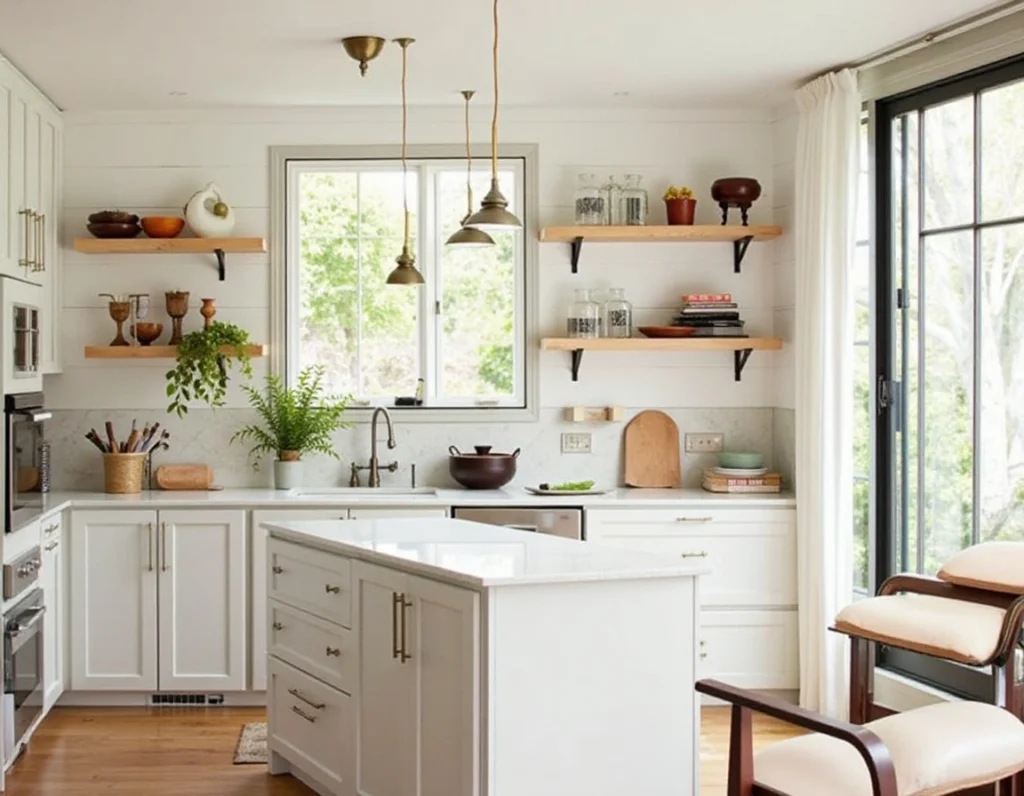
There’s a sweet spot between “I can totally do this myself” and “I should probably not ruin my cabinets.” Figuring out where your project falls on that spectrum? That’s the real skill.
If you’re just swapping hardware or adding open shelves, go for it. You don’t need a contractor for a screwdriver and a level. Same with lighting—changing bulbs, sticking on LED strips, even replacing a pendant is all fair game if you’ve got the patience.
But if we’re talking full cabinet refinishing, stripping, sanding, and staining, pause. That’s a commitment. Wood behaves differently than it looks online. Grain patterns, old finishes, and weird absorption spots can turn a straightforward plan into a “Why is this patch blotchy?” moment fast. If your cabinets are a major focal point and you’ve never refinished wood before, it might be worth calling in a pro—at least for the messy part.
That said, hybrid approaches work. I’ve had readers who hired someone just to strip the cabinets, then took over the staining and sealing themselves. It saved money, kept them hands-on, and avoided most of the chaos.
Here’s when to go pro:
-
Cabinets have old lacquer or mystery finishes that resist sanding
-
You want a consistent tone across different wood types
-
The layout’s staying, but the doors need replacing or resizing
-
You’re already overwhelmed and need this off your plate
What’s a smart middle ground for a kitchen refresh?
Try a two-part plan: hire out the structural or high-skill stuff (like stripping or installing new doors), and DIY the style elements—staining, painting walls, swapping hardware. You get the transformation without the full-blown cost or chaos.
Inspiration Gallery Warm Wood That Just Feels Right
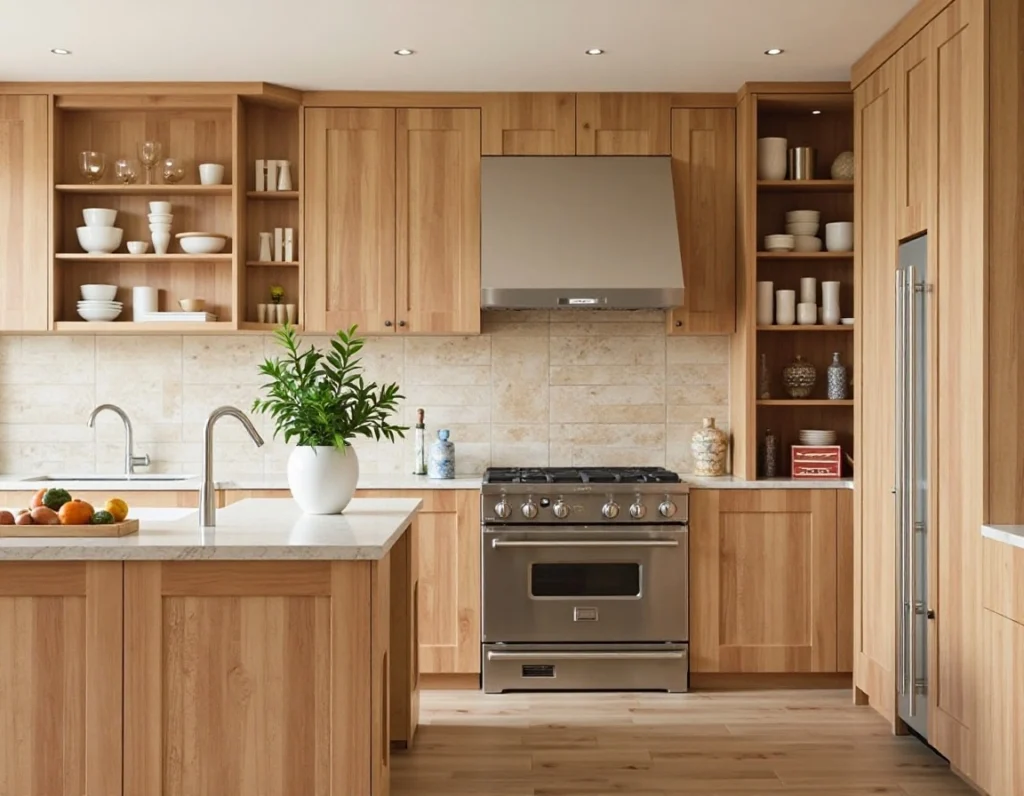
Let’s be honest, sometimes you don’t need advice. You need pictures. Proof. That little jolt of “Oh wow, that actually works.” Warm wood cabinets can be tricky in your head, but in real spaces? They’re magic when done right.
I’ve seen kitchens that stopped me mid-scroll. Not because they were fancy, but because they felt right. A white oak island under soft pendant lighting. Walnut cabinets paired with sage green walls and antique brass pulls. Or a tiny galley kitchen where the honey-toned wood practically glowed under cool-toned counters.
These aren’t museum kitchens. They’re lived-in. Imperfect. The kind you picture making Sunday waffles in.
A few design combos that hit different:
-
White oak + matte black hardware — clean, soft, grounded
-
Cherry shaker cabinets + pale sage paint — rich but calm
-
Walnut slab doors + terrazzo or concrete counters — modern edge, cozy heart
-
Two-tone mix (wood lowers, painted uppers) — balance without being boring
-
Open shelves + wood cabinets — breaks up the visual weight
And here’s a little secret: sometimes the best inspiration doesn’t come from designers. It comes from regular folks posting their real, slightly messy kitchens online. Look for stories, not just staged shots.
How do I know what will actually work in my kitchen?
Start small. Create a Pinterest board or mood folder. Screenshot anything that makes you pause. Then look for patterns—colors, materials, vibes. Your taste is already there; you’re just translating it into cabinets and tile.
Conclusion: It Was Never Just About the Cabinets
Funny thing—when I started messing with old kitchen cabinets, I thought I was just changing wood tones. But it was more than that. I was shifting the feeling of a space. Turning something overlooked into something alive again.
Warm wood doesn’t shout for attention. It just quietly makes a room feel settled. Like it’s been through a few stories. Like it belongs.
If you’ve got cabinets that feel too warm, too dated, too something… maybe they’re not the problem. Maybe they just need a better frame—a cooler wall color, a modern light, or even just the confidence not to paint over what’s already working.
You don’t need a remodel. You just need a reframe. And if you try something and it doesn’t work? That’s okay too. Kitchens, like people, evolve.
So go ahead—sand one drawer. Change one handle. See what happens.

